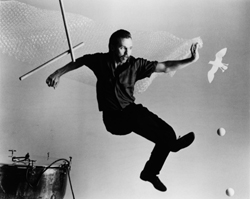Halloween Concert – Costumes Galore!
University Symphony Orchestra and University Philharmonic Orchestra
Program:
March of the Little Goblins —————————————— Adam Glaser
Overture to Die Fledermaus (The Bat) —————————– Johann Strauss, Jr.
Night on Bald Mountain ———————————————Modest Mussorgsky
The Fairy Garden from Mother Goose —————————-Maurice Ravel
Funeral March of the Marionettes ———————————Charles Gounod
Storm from Peter Grimes ——————————————- Benjamin Britten
Witches’ Sabbath from Symphonie Fantastique —————–Hector Berlioz
The Ride of the Valkyries ——————————————-Richard Wagner
Star Wars Medley—————————————————– John Williams
Wow – I never thought serious musicians would ever dress up in crazy costumes for a classical music concert! But when I walked into Hill Auditorium, the first thing I saw was the sea of bumblebees, angels, bunnies, and other, interesting yet occasionally unidentifiable costumes. Fully impressed, I thought back to my high school days when our conductor told us to dress up for the holiday concerts, and I was the only one in the violin section with reindeer antlers.
Before each piece, the conductor walked on staged and gave a little introduction to the piece through a comical skit which left the audience laughing. The conductor of “The Fairy Garden” frolicked and skipped on stage in an elaborate ballerina-like costume complete with a giant tutu and colorful leggings. My favorite was the “invisible” conductor for the “Witches’ Sabbath.” Creaky door sounds and footsteps sounds were played as the stage door opened and closed (no person passed through), but the most mysterious part was when the music, or rather, a giant piece of cardboard, on the stand flipped back and forth. This happened several time times during the piece and though I scrutinized every slight movement of the first row of musicians, I could not figure out who was moving the “music!”
All the pieces in this program were pretty short, living up to the advertised “fun for the entire family.” Maybe I’m used to long symphonies and concertos – I actually wished the pieces were a little longer, but the short concert is perfect for friends who may not be as interested in long classical pieces.
By far, the best part of the concert was the encore when the orchestra played the “Ghostbusters” theme song and the conductors danced on staged, especially since I knew one of the conductors from when I played in the Campus Symphony Orchestra!
At the end, one of the conductors asked the audience who had attended the concert last year. Many people raised their hands. Then he asked about the past 5 years. The past 10 years. And finally, the past 20 years – several people raised their hands! I loved the enthusiasm of the whole orchestra – they wanted to be there and they were excited to play for the audience. And we were all just as excited to watch the performance. 1 year down, 19 more to go!





